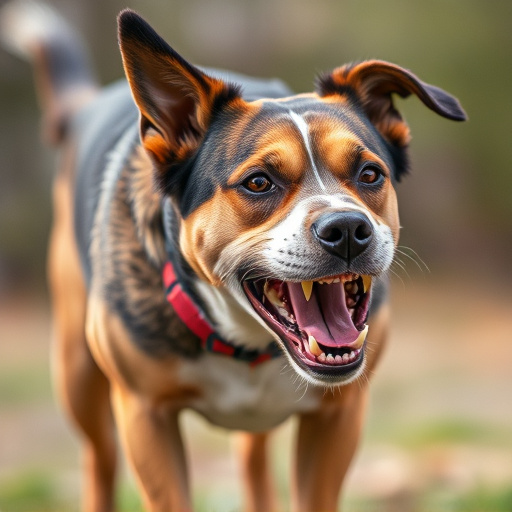Dog pepper spray defense relies on the Mace canine spray pattern width to temporarily disable aggressors. Wider patterns for larger dogs or multiple attackers, narrower ones for smaller, faster creatures. Local regulations govern usage, with legal implications varying by region. Mastering the 3-4 meter (10-13 feet) pattern width ensures optimal coverage and minimizes collateral damage. Regular practice and training sessions improve deployment accuracy. Training dogs to avoid exposure through positive reinforcement techniques enhances their safety during unexpected encounters.
In today’s world, knowing how to protect yourself and your loved ones from unexpected threats is paramount. One often-overlooked tool in personal safety is dog pepper spray—a non-lethal deterrent that can diffuse aggressive canine encounters. This comprehensive guide delves into the science behind dog pepper spray defense mechanisms, exploring crucial factors like Mace canine spray pattern width for maximum effectiveness. We’ll navigate legal considerations, uncover optimal application techniques, and even provide tips on training your dog to avoid exposure.
- Understanding Dog Pepper Spray Defense Mechanisms
- How Mace Canine Spray Pattern Width Impacts Effectiveness
- Legal Considerations for Using Pepper Spray on Dogs
- Effective Application Techniques for Optimal Protection
- Training Your Dog to Avoid Pepper Spray Exposure
Understanding Dog Pepper Spray Defense Mechanisms
Dog pepper spray defense mechanisms are designed to protect both pets and their owners from potential threats. When deployed, dog pepper spray creates a localized area of discomfort, temporarily impairing an attacker’s vision and breathing. The primary goal is to enable the owner or the dog itself to escape or deter an aggressor.
The Mace canine spray pattern width plays a significant role in its effectiveness. A well-designed spray pattern ensures that the irritant reaches potential attackers while minimizing collateral damage to non-target areas. Understanding these defense mechanisms and how they work can provide owners with valuable insights into keeping themselves and their dogs safe, especially during unforeseen encounters.
How Mace Canine Spray Pattern Width Impacts Effectiveness
The effectiveness of dog pepper spray, often referred to as Mace, depends in part on its pattern width. Wider spray patterns allow for greater coverage, making it easier to deter and incapacitate an attacker. This is particularly important when defending against larger dogs or multiple assailants. A narrower spray pattern requires closer proximity, which can be riskier and less effective if the target is unpredictable or aggressive.
When choosing a dog pepper spray, users should consider their typical threats: smaller, faster animals that require precise targeting, or larger, more powerful dogs that demand broader coverage. Understanding the Mace canine spray pattern width ensures owners select a product tailored to their specific needs, enhancing personal safety during potential confrontations with canines.
Legal Considerations for Using Pepper Spray on Dogs
Using pepper spray as a defense against dogs is a controversial topic, with legal implications that vary widely depending on location. It’s crucial to understand the specific regulations surrounding Mace canine spray in your area before considering it as an option for personal protection. In many jurisdictions, there are strict rules about who can possess and deploy such devices, as well as the circumstances under which they can be used.
For instance, some regions limit its use only to trained law enforcement officers or require individuals to obtain special permits. Additionally, the pattern width of the spray—typically around 3-4 meters (10-13 feet)—dictates its effective range and the potential for collateral damage. Using pepper spray on a dog must adhere to these legal parameters to avoid fines, legal repercussions, and potential harm to bystanders or pets.
Effective Application Techniques for Optimal Protection
When it comes to effective dog pepper spray defense, understanding application techniques is key for optimal protection. The first step involves mastering the Mace canine spray pattern width. Aiming directly at the face and eyes of an attacking dog is crucial, as this area contains numerous nerve endings, making it highly sensitive to the spray’s effects. A proper spray pattern should be a cone-shaped stream, ensuring coverage without wasting valuable product.
After mastering the technique, practice in various scenarios to become proficient in quick, accurate application. Remember, timing is essential; you want to deploy the spray before the dog gains physical contact. Regular training sessions will ensure your defense remains effective, allowing you and your pet to remain safe during potential encounters.
Training Your Dog to Avoid Pepper Spray Exposure
Training your dog to avoid pepper spray exposure is crucial for their safety and well-being during unexpected encounters. Start by teaching basic obedience commands like “sit,” “stay,” and “come.” These commands will help maintain control in stressful situations. Use positive reinforcement techniques, such as treats and praise, to encourage good behavior.
Next, introduce your dog to the concept of a Mace canine spray pattern width. Simulate the spray’s motion without actually using it, and reward them for remaining calm and following your commands. Gradually increase the intensity of the simulation over time. This step ensures your dog understands that certain movements and behaviors will trigger a response, allowing them to make quicker, safer decisions when confronted with actual pepper spray.
Dog pepper spray defense mechanisms have evolved significantly, with products like Mace Canine Spray designed to create an effective barrier against aggressive dogs. Understanding the spray pattern width and optimal application techniques is crucial for ensuring its effectiveness. Additionally, legal considerations and training your dog to avoid exposure are vital components of a comprehensive strategy to protect yourself and your loved ones. By combining these elements, you can navigate potential dog encounters with greater confidence and safety.
